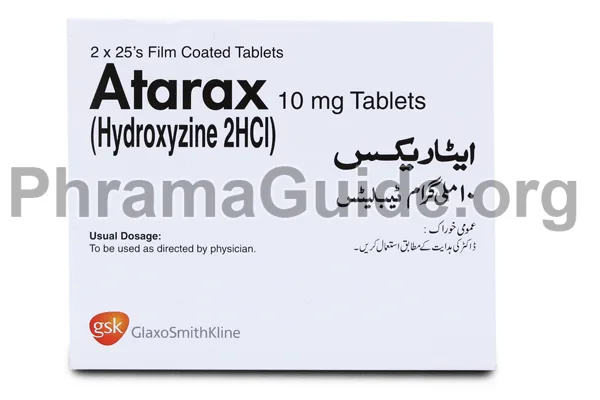Atarax is an antihistamine medication that is used to treat various conditions, including itching, anxiety, and allergies. Like any medication, it can cause side effects. Not everyone will experience these side effects, and some people may experience them to varying degrees.
Common Side Effects of Atarax
- Drowsiness: One of the most common side effects of Atarax is drowsiness or sedation. This effect can be significant, and it’s why the medication is sometimes used to manage anxiety or as a sleep aid.
- Dry Mouth: Dry mouth (xerostomia) is another common side effect of Atarax. Staying well-hydrated and using sugar-free gum or candies may help alleviate this symptom.
- Dizziness: Some people may experience dizziness or lightheadedness while taking Atarax.
- Blurred Vision: Blurred vision is another potential side effect, and it’s important not to engage in activities that require clear vision, such as driving, if you experience this symptom.
- Constipation: Atarax may lead to constipation in some individuals.
- Difficulty Urinating: It can also cause difficulty urinating or urinary retention, especially in men with an enlarged prostate.
- Headache: Headaches are a relatively common side effect.
- Stomach Upset: Nausea or an upset stomach can occur in some cases.
- Weight Gain: While not common, some individuals may experience weight gain while taking Atarax.
- Nervousness or Excitability: Paradoxically, some people may experience nervousness or increased anxiety as a side effect.
- Allergic Reactions: Although rare, some people may experience allergic reactions, which can manifest as skin rash, itching, swelling, severe dizziness, or difficulty breathing. Seek immediate medical attention if you experience these symptoms.

What is Atarax?
Atarax is one of the leading brands of Hydroxyzine HCL, manufactured and marketed by GSK Pharma Pakistan.
Atarax : Available Formulations and Strengths
Presently, Atarax is available in Tablet Form
Atarax Tablets : 10mg, 25mg, and 50mg Strengths
What Are The Possible Drug Interactions of Atarax?
- Central Nervous System Depressants: Atarax can enhance the sedative effects of other central nervous system depressants, such as alcohol, benzodiazepines (e.g., lorazepam, diazepam), and sedative medications. This combination can lead to excessive drowsiness, dizziness, and impaired coordination. It’s important to avoid the concurrent use of these substances.
- Antihistamines: Combining Atarax with other antihistamines may increase the risk of drowsiness and other side effects. It’s generally best to avoid using multiple antihistamines simultaneously.
- MAO Inhibitors: Monoamine oxidase inhibitors (MAOIs), which are used to treat depression and anxiety, can interact with Atarax and result in severe hypertension (high blood pressure). MAOIs should not be used with Atarax.
- QT-Prolonging Medications: Atarax may prolong the QT interval on an electrocardiogram, and combining it with other medications that have the same effect can increase the risk of irregular heart rhythms. These medications include certain antiarrhythmics, antipsychotics, and antibiotics. Your healthcare provider should be cautious when prescribing these in combination.
- Opioid Medications: Combining Atarax with opioid medications (e.g., codeine, oxycodone) can enhance sedation and respiratory depression. It’s essential to use these drugs together only under close medical supervision.
- Anticholinergic Medications: Combining Atarax with other medications that have anticholinergic properties, such as tricyclic antidepressants (e.g., amitriptyline), can increase the risk of dry mouth, constipation, and other side effects.
- Muscle Relaxants: The concurrent use of Atarax with muscle relaxants can enhance sedation and drowsiness. Your healthcare provider should monitor you closely when using these drugs together.
- Blood Pressure Medications: Atarax can increase blood pressure, and combining it with certain blood pressure medications may affect the control of hypertension. Close monitoring of blood pressure is necessary if these drugs are used together

Leave A Comment